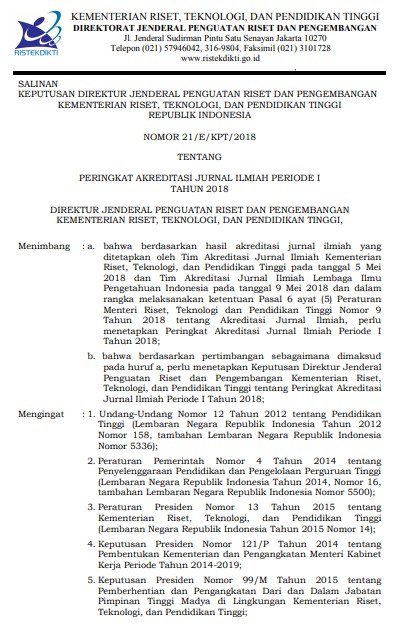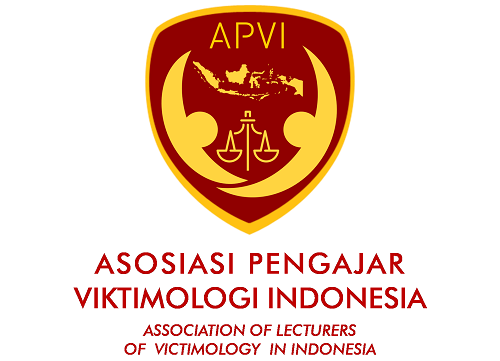Characteristics of Cryptoasset-Related Crimes and Convergence-Based Law Enforcement Policies
Abstract
Crimes related to cryptoassets that develop in a complex manner give rise to distinctive characteristics and require a convergence-based countermeasure that is not only responsive but also anticipatory and futuristic. This article is examined from normative juridical research with a case and conceptual approach and aims to study the characteristics of crimes related to cryptoassets and how to formulate convergence-based law enforcement policies in Indonesia. This crime has the characteristics of convergence between financial crimes and cybercrime, occurs in cyberspace and is carried out by actors who are described not only from cryptoasset transaction actors, but also third parties who provide services related to cryptoasset transactions. Law enforcement policies in tackling these crimes must have a convergence load with various technological innovations, including data storage and crime investigation using a blockchain system, including verification of cryptoassets using a chain of custody architecture and confiscation and confiscation of cryptoassets related to crime. The formation of convergence-based criminal policies cannot be separated from awareness and continuous efforts to develop the quality of human resources in digital literacy. This quality is not only described in the mastery of technology alone but also in ethical behavior. This digital ethics-based legal culture should not only be aimed at the general public as a norm target (norm address), but also for law enforcement officers (rechtshandhaving).
Full Text:
PDF View
References
Jurnal:
Archana N. M. (2016), Bitcoins,Its Advantages and Security Threats, International Journal of Advanced Research in Computer Engineering & Technology (IJARCET), Vol. 5, (No. 6), Pp.
Bakar,N.A., Rosbi, S., & Uzaki,L. (2017), Cryptocurrency Framework Diagnostics from Islamic Finance Perspective: A New Insight of Bitcoin System Transaction. International Journal of Management Science and Business Administrative, Vol. 4, (No. 1), Pp. 19–28. Doi: 10.18775/ijmsba.1849-5664-5419.2014.41.1003
Beshiri, A. S. and Susuri, A.(2019), Dark Web and Its Impact in Online Anonymity and Privacy: A Critical Analysis and Review. Journal of Computer and Communications, Vol. 7, (No.3),pp. 30-43. https://doi.org/10.4236/jcc.2019.73004
Budhijanto, D. (2011). Pembentukan Hukum yang Antisipatif Terhadap Perkembangan Zaman Dalam Dimensi Konvergensi Teknologi Informasi dan Komunikasi. Jurnal Ilmu Hukum, Vol. 14 (No. 2, September), pp.225-255.
Chan, S., Chu, J., Nadarajah, S., & Osterrieder, J. (2017), A Statistical Analysis of Cryptocurrencies. Journal of Risk and Financial Management, Vol 10, (No.2), Pp. 1-23. https://doi.org/10.3390/jrfm10020012
Eunhee, Kim,J.J., & Kim, J.K. (2014), Convergence in information and communication technology (ICT) using patent analysis, Journal of Information Systems and Technology Management, Vol.11, (No.1), pp. 53-64. https://doi.org/10.4301/S1807-17752013000100004
Jung,J.Y., & Lee,J.L. (2017), Contemporary Financial Crime, Journal of Public Administration and Governance, Vol. 7,( No. 2), pp. 88-90.
Legrand, P. (1996), European Legal Systems Are Not Converging, The International and Comparative Law Quarterly, Vol. 45, ( No. 1), Pp. 52-81.
Li, X. (2017), A Review of Motivations of Illegal Cyber Activities. Criminology & Social Integration Journal, Vol. 25, (No. 1), Pp. 110-126.
Marriott, L. (2019). White-Collar Crime: The Privileging of Serious Financial Fraud in New Zealand, Social & Legal Studies, Vol.29, (No.4), pp.486-506. Doi:10.1177/0964663919883367
Mir, S., & Quadri, S. (2016), Information availability: An insight into the most important attribute of information security. Journal of Information Security, Vol.7, (No.3), Pp. 185-194.
Ramli, A.M.(2008), Dinamika Konvergensi Hukum Telematika Dalam Sistem Hukum Nasional, Jurnal Legilasi Indonesia,Vol.4, (No.5), pp. 1-2.
Rawat, D.B., Chaudhary, V. Doku, R. (2020), Blockchain Technology: Emerging Applications and Use Cases for Secure and Trustworthy Smart Systems, Journal of Cybersecurity and Privacy, Vol.1, (No. 1), Pp. 4-18. https://doi.org/10.3390/jcp1010002
Rodrigues,R. (2020), Legal and human rights issues of AI: Gaps, challenges and vulnerabilities, Journal of Responsible Technology, Vol. 4, pp. 1-36. http://dx.doi.org/10.2139/ssrn.3320884
Saddiq, S.A. and Abu Bakar, A.S. (2019), Impact of economic and financial crimes on economic growth in emerging and developing countries: A systematic review. Journal of Financial Crime, Vol. 26, (No.3), pp. 910-920. https://doi.org/10.1108/JFC-10-2018-0112
Salam, A.(2015), Pengaruh Politik Dalam Pembentukan Hukum Di Indonesia. Jurnal Pemikiran Hukum Islam, Vol. XIV, ( No. 2), pp.6.
Scherer,M.U. (2016), Regulating Artificial Intelligence Systems: Risks, Challenges, Competencies, and Strategies, Harvard Journal of Law & Technology, Vol. 29, (No. 2), pp. 354-398.
Simpson, B., & Murphy, M. (2016) Technological challenges and opportunities: the future of law. Information & Communications Technology Law, Vol.25 (No.1), pp. 1- 3.
Srivastava, A., Bhattacharya, P., Singh, A., & Mathur, A. (2018), A Systematic Review on Evolution of Blockchain Generations. International Journal of Information Technology Engineering, Vol.7, (No. 6), Pp.1-8.
Srivastava, Abhishek., Bhattacharya , Pronaya,. Singh, Arunendra,.& Mathur, Atul Mathur.(2018) A Systematic Review on Evolution of Blockchain Generation. International Journal of Information Technology and Electrical Engineering, Volume 7, (No. 6), pp.3-5
Xu, M.; Chen, X.; Kou, G. (2019), A systematic review of blockchain. Financial Innovation, Vol. 27 (No.27), Pp. 1-14. https://doi.org/10.1186/s40854-019-0147-z
Buku:
Andress, J. (2014). The Basics of Information Security: Understanding the Fundamentals of InfoSec in Theory and Practice. USA: Syngress.
Chainanalysis. (2020). The 2020 State of Crypto Crime. Chainanalysis.
Friedman,L.M. (1975). The Legal System, A Social Science Perspective. New York: Russel Sage Foundation.
Gottschalk, P. (2010). White- Collar Crime Detection, Prevention and Strategy in Business Enterprises. Florida United State of America: Universal-Publishers.
Kusumaatmadja,M. (1976). Hukum dan Masyarakat dan Pembinaan Hukum Nasional. Bandung:Penerbit Binacipta.
Kusumaatmadja,M. (2006). Konsep-Konsep Hukum dalam Pembangunan, Bandung: Penerbit PT. Alumni.
Kusumastuti, F., Astuti,S.I,. Astuti,Y.D,. Birowo,M.A,. Hartanti, L.E.P,. Amanda,N.M.R, & Kurnia,N. (2021). Modul Etis Bermedia Digital, Jakarta: Kementerian Komunikasi dan Informatika.
Manullang, E.M.( 2007). Menggapai Hukum Berkeadilan Tinjauan Hukum Kodrat dan Antinomi Nilai (Cetakan kedua). Jakarta: PT. kompas Media Nusantara.
Rahardjo,S. (2010). Pemanfaatan Ilmu-Ilmu Sosial Bagi Pengembangan Ilmu Hukum (Cetakan kedua). Yogyakarta: Genta Publishing.
Rahardjo,S. (2014). Ilmu Hukum. Bandung: PT. Citra Aditya
Prosiding:
Ackermann, J. & Meier, M. (2018). Blockchain 3.0 The Genegeration of Blockchain System. In Proceeding of Advanced Seminar Blockchain Technologies Summer Term 2018 (pp. 1-2). Germany: Technical University Munich.
Ackermann,J., & Meier, M.(2018). The next generation of blockchain systems, In the Proceeding of Advanced Seminar Blockchain Technologies (pp.1-7), Jerman: Technical University Munich.
Bonomi,S., Casini, M., & Ciccotelli,C. (2018), B-CoC: A Blockchain-Based Chain of Custody for Evidences Management in Digital Forensics. In the Proceeding of International Conference on Blockchain Economics, Security and Protocols ( Pp. 12:1–12:15), Jerman: Dagstuhl Publishing.
Naseem, I., Kashyap,A.K., & Mandloi,D.(2017). Exploring Anonymous Depths of Invisible Web and the Digi-Underworld, In Proceeding of National Conference on Contemporary Computing (pp.21-24). USA: IJCA.
Spagnuolo, M., Maggi, F., and Zanero, S. (2014). Bitiodine: extracting intelligence from the bitcoin network. In the Proceeding for International Conference on Financial Cryptography and Data Security (Pp. 457–468). Berlin, Heidelberg: Springer.
Yulianto, H., Santi, R. C. N., Hadiono, K., & Mulyani, S. (2018). Implementasi Sederhana Blockchain. In Prosiding Sintak 2018: Industrial Revolution 4.0 Toward Smart City for Better Indonesia (pp.306-307). Semarang: Universitas Stikubang. ISBN 978-602-8557-20-7.
Sumber Online:
EUROPOL. (2018). INTERNET ORGANISED CRIME THREAT ASSESSMENT (IOCTA), European Union Agency for Law Enforcement Cooperation 2018. Retrieved from https://www.europol.europa.eu/internet-organised-crime-threat-assessment-2018
Kementerian Hukum dan Hak Asasi Manusia Republik Indonesia. (2018). Dinamika Konvergensi Hukum Telematika dalam Sistem Hukum Nasional, Retrieved from https://ditjenpp.kemenkumham.go.id/index.php?option=com_content&view=article&id=668:dinamika-konvergensi-hukum-telematika-dalam-sistem-hukum-nasional&catid=107:hukum-teknologi-informasi&Itemid=187
Nem Blockchain. (2020). NEM Blockchain Solutions for Law Enforcement. Retrieved from https://blog.nem.io/nem-blockchain-solutions-for-law-enforcement/
Skripsi:
Sormin, D., A. (2018). Studi Perbandingan Perlindungan Hukum Bagi Pengguna Bitcoin di Amerika Serikat, Jepang, dan Indonesia. Universitas Sumatera Utara.
DOI: http://dx.doi.org/10.20884/1.jdh.2023.23.2.3478
Refbacks
JURNAL DINAMIKA HUKUM Indexed by :
 | Jurnal Dinamika Hukum | |
| Faculty of Law, Universitas Jenderal Soedirman | Copyright of Jurnal Dinamika Hukum | |
| Yustisia IV Building, Law Journal Center | ISSN 2407-6562 (Online) ISSN 1410-0797 (Print) | |
| Purwokerto, Central Java, Indonesia, 53122 | JDH is licensed under a Creative Commons Attribution 4.0 International License | |






